Since we have been “hiding out” from the storm, Dr. Ashjian decided we could do a science station in the ice. It was not a planned station, but we might as well see what's here! Yesterday, right after breakfast, we conducted a science station. Science operations included a CTDA research tool that is submerged in the water to measure conductivity (salinity), temperature, and depth., ring net, Bongo nets and ice retrieval. The station went so well, that Dr. Ashjian and Healy Science Ops added an entire new sampling line...the YUK line! Dr. Longnecker asked if the YUK was an abbreviation for the Yukon Rover or if it was an indication of the weather!
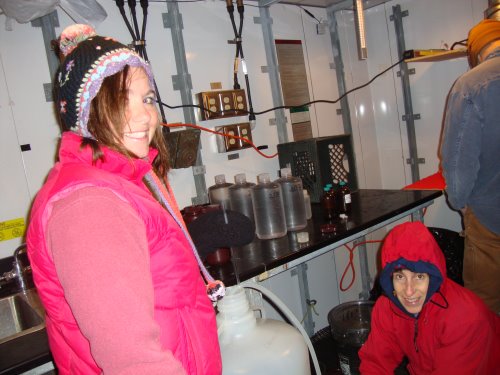
We got some interesting fish from one of the tows. Very interesting! We saved them in the Cold Room for Joel, fish expert!
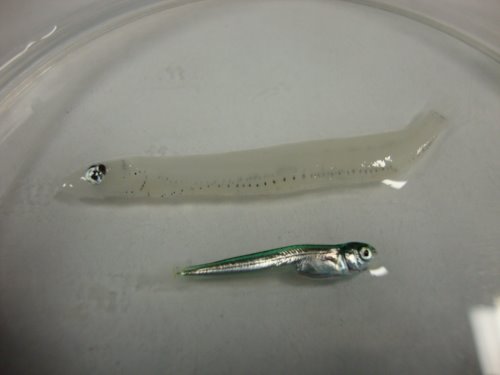
We also had time to get the THREE top women of the ship together; Engineering Officer CMDR King, Chief Scientist, Dr. Carin Ashjian and Captain of the USCG Healy CPT Beverly Havlik.
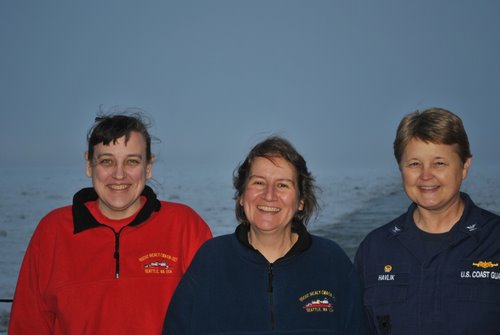
Meet Dr. Sam Laney, phytoplankton expert. I have really enjoyed talking to Dr. Laney about his work, both aboard and off Healy. One of the experiments he has been conducting aboard Healy was an experiment to see if he could simulate springtime and “trick” the phytoplankton into their spring bloom. Though the results have yet to be fully analyzed, he definitely got some data to use to springboard his next idea.
Like the Coast Guard, scientists also have "ranks" and "rates". Sam's rank (job title) is "Assistant Scientist" in the Biology Department at Woods Hole Oceanographic Institution. That means he's an entry level researcher who has recently gotten a Ph.D. and who now runs his own research group. Sam's "rate" (specialty) is in phytoplankton ecology, a subdiscipline of biological oceanography. He studies photosynthesis in the ocean, which is performed by phytoplankton (microscopic, floating plants).
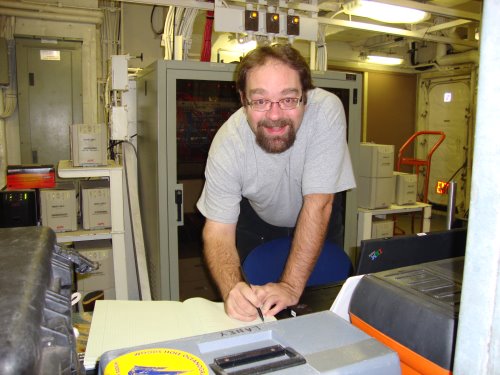
When I asked Sam to describe his education, he said it in 2 words - It's long. Five years after high school, earning a Bachelors in Biology and Engineering at Cornell. Then, two years as a research scholar with the Department of Energy at Brookhaven National Lab on Long Island, in an oceanography division. (Then several years in industry - not a formal education but very educational). Then, he earned a PhD in Oceanography at Oregon State University, with a minor in Electrical Engineering and Computer Science. Then, a Postdoctoral Scholarship at Woods Hole (like an apprentice program). The common theme in Sam's education after high school is that he always tried to mix science with "practical" skills. Here, the practical skills were the engineering classes he took. Having that background allows him to build custom research equipment to suit his needs. This means he doesn't have to rely on what is manufactured, and so he can dream up and follow research questions hat are very open, even if no equipment exists (yet) to do that research. Having a background in industry also helps - there are a lot of skills in industry that can be applied to oceanography.
When I asked Sam what he enjoys most about his job, he said that he rarely does the same thing day after day. He usually have several projects in play at any given time, some of which are building equipment, some are analyzing data, some are writing scientific papers, some are field work, some are lab work. Month to month it's the same: the first part of the year he was teaching graduate students, then a few weeks at sea on Healy, then back on shore for a month, then back to sea, and teaching will start again in February. So it's a career where you can exercise a bunch of different skills that you may have. Sam would be less happy in a job where he had to teach full-time, or do research full-time.
When asked what advice would you give someone who may be interested in your career field, Sam's first comment was don't shy away from math! Biology more and more relies on folks who have good math skills, and a lot of students get turned off from math early in school because it doesn't look like it has any relevance (or is boring). It's quite the opposite: math has everything to do with biology. Second, make sure your activities include using your hands as well as your head and try to gain practical experience as much as you can. For example, in high school, participate in out-of-class or summer activities such as volunteering in science projects or local labs. There is always work for entry-level people interested in learning about science. In college, also arrange for summer opportunities or internships that will let you develop real-world skills in science and research that will set you apart from others when it comes time to apply for jobs or student positions.
I will leave you with an ice picture...it has been days since we have seen the gorgeous Arctic sun, but the ice is a welcome change from the open water!
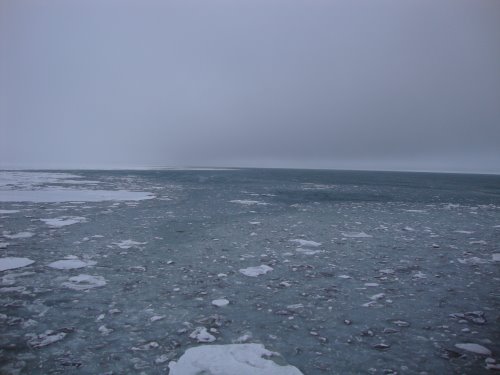
Stay tuned as we continue our exciting voyage on the USCG Cutter Healy. Until then...
“Live as if you were to die tomorrow. Learn as if you were to live forever” - Mohandas Gandhi


Comments